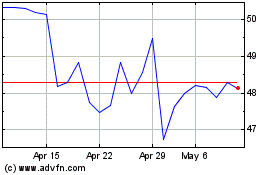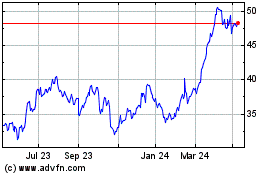By David Gauthier-Villars in Istanbul, Mark Maremont in Boston, Sean McLain in Tokyo and Nick Kostov in Beirut
This article is being republished as part of our daily
reproduction of WSJ.com articles that also appeared in the U.S.
print edition of The Wall Street Journal (January 4, 2020).
Former auto titan Carlos Ghosn, packed into a case typically
used for concert audio equipment, was sneaked onto a private jet at
an airport in Osaka, Japan, late Sunday, according to people
familiar with the matter, in what has become one of the corporate
world's most stunning cases of bail jumping.
His escape from Japan, where he was fighting charges of
financial crime stemming from his time at the top of Nissan Motor
Co. and Renault SA, was months in the making, according to people
familiar with the matter, and was put in motion only after Mr.
Ghosn became convinced that his trial, slated for later this year,
could drag on for years.
Mr. Ghosn, who is 65 years old, has said he arranged his escape
on his own, but he was accompanied on his flight from Osaka to
Istanbul, these people said, by an expert in the art of clandestine
getaways: Michael Taylor, a former Green Beret well-known in the
small, tight world of private security contractors.
This account of his journey is based on interviews with people
familiar with a Turkish probe of two planes used in the escape,
photos that are part of that probe, and conversations with people
familiar with Mr. Ghosn's thinking and the planning and execution
of the escape. A spokeswoman for Mr. Ghosn declined to comment on
how he left Japan.
As last year neared its end, Mr. Ghosn became increasingly
distraught at the prospect of a drawn-out trial. He was living in a
court-monitored house in Tokyo, with severe restrictions on contact
with his family. While he was free to leave his home, he wasn't
allowed to leave Japan.
Since his arrest in November 2018, he had challenged Japanese
charges of financial wrongdoing, and vowed to fight them in
court.
But following a pretrial hearing on Christmas Day that suggested
a further delay in the trial's start, Mr. Ghosn decided to move to
Plan B, according to people familiar with the matter.
The escape plan was under way by Saturday, Dec. 28, in Dubai.
That was where, according to flight manifests and immigration
records now part of the Turkish probe, Mr. Taylor and another man
boarded a Bombardier Global Express private jet bound for Japan.
Dubai was also where two large black cases were loaded for the
red-eye flight. The plane arrived at Osaka's busiest airport at
10:16 a.m. local time Sunday, according to flight records.
Japan's Asahi newspaper, citing Japanese investigative sources,
said surveillance footage showed Mr. Ghosn leaving his Tokyo house
alone at 2:30 p.m. Sunday, wearing a hat and a surgical-style mask
used widely in Japan to protect from germs. That would have been
less than nine hours before his plane left Japan.
How he traveled the more than 300 miles to Osaka from Tokyo is
still a mystery. It also hadn't been known previously how Mr. Ghosn
was able to board the private jet as he was barred from leaving the
country. Kenji Takanishi, a spokesman for the operator of Osaka's
Kansai International Airport, said luggage for private planes goes
through the same inspection as passengers' luggage for regular
commercial jets. However, he said VIPs were sometimes exempted from
such checks.
The container used to sneak Mr. Ghosn aboard had holes drilled
at the bottom to ensure he could breathe, according to people
familiar with the matter. It also had wheels, typical for such
cases, making it easier to move around.
Mr. Ghosn's flight to Istanbul left at 11:10 p.m. Sunday and was
in the air for just over 12 hours, passing over Russia before
descending to Ataturk airport, according to flight records. In
addition to the passengers, the plane carried two pilots and a
flight attendant, the people familiar with the Turkish probe
said.
On the ground at Ataturk airport Monday morning in driving rain,
a ground staff member took a photo of Mr. Ghosn, according to
people familiar with the matter. That photo is in the hands of
Turkish prosecutors. Mr. Ghosn was then driven in a car some 100
yards across the tarmac to a smaller jet that ferried him to
Lebanon on Monday.
Turkey-based aircraft operator MNG Jet Havacilik AS, which
operated the two planes used in Mr. Ghosn's journey, found the
black container, and another holding loudspeakers, on the
long-range aircraft after its flight from Japan.
On the subsequent flight, from Turkey to Lebanon, Mr. Ghosn was
accompanied by an employee of MNG Jet. The company has filed a
complaint against the employee, accusing him of doctoring records
to hide Mr. Ghosn's presence on the flights.
The employee explained to investigators how one of the black
cases had been used to load Mr. Ghosn onto the plane in Osaka, the
people familiar with the matter said.
A photo of the long-range plane's cabin, provided to The Wall
Street Journal by people familiar with the probe, shows a black
container, with metal-reinforced corners, wedged into the central
aisle near the back of the aircraft.
The audio-equipment boxes have become central evidence in the
Turkish investigation.
"Inside a box, Mr. Ghosn was mere cargo transiting through
Istanbul," one of the people said. "The minute he stepped out of
it, he became a possible illegal alien. He should have remained in
the box all the way to Beirut."
On Thursday and Friday, Turkish authorities questioned the MNG
Jet employee and eight other people in connection with the flights.
A lawyer for the employee, Okan Kosemen, said his client didn't
commit any crime. The attorney, Mehmet Fatih Danaci, said he
couldn't discuss the specifics of the case.
On Friday, Turkish prosecutors said they had charged Mr. Kosemen
and four pilots who hail from the Turkish air force with migrant
smuggling. The five men were sent to jail pending trial.
Mr. Taylor didn't accompany Mr. Ghosn on the flight to Lebanon,
where the private contractor has close ties. He is married to a
Lebanese woman and two of his sons live in the country.
The other man traveling with Mr. Taylor was identified as George
Antoine Zayek, according to people familiar with the matter. A
George Zayek has served as a security employee at companies owned
by or linked to Mr. Taylor, according to online profiles posted to
job-networking websites.
Mr. Taylor made headlines when the New York Times hired his
former firm, Boston-based American International Security Corp., to
help extract reporter David Rohde from Taliban captivity in
Afghanistan in 2009.
Mr. Taylor more recently served time in a U.S. prison after
pleading guilty to a wire-fraud charge stemming from a federal
bid-rigging investigation into $54 million in Defense Department
contracts. Mr. Taylor through his attorney had disputed the
charges, saying he was a legitimate businessman. He was released in
December 2015, according to the U.S. Bureau of Prisons inmate
locator. The government returned $2 million seized from him, court
documents show.
After landing in Turkey on Monday, Mr. Taylor and the man
identified as Mr. Zayek made their way to Istanbul's new airport
and took a commercial flight to Beirut, passing through Turkish
passport checks on arrival and departure, the people familiar with
the Turkish probe said.
Turkish investigators have copies of both men's passports
showing exit stamps from Japan and Turkey, these people said.
When Mr. Ghosn arrived in Beirut on Monday morning, he sent a
friend a message a little before 8 a.m. saying in French simply.
"Hello. Call me, " according to a person familiar with the
situation.
The friend called him. Mr. Ghosn told him he was in Beirut. The
friend hung up, washed his face and called back. They met later
that day.
Mr. Ghosn and his wife, Carole Ghosn, celebrated New Year's Eve
at the house of a friend, according to a person familiar with the
matter. That night, Mrs. Ghosn told the Journal that the couple was
"so happy" and described being reunited with her husband as the
"best gift of my life."
Mr. Ghosn has been spending time in a pink mansion in Beirut
that Nissan bought and renovated for his use when he worked for the
Japanese car maker, according to a person familiar with the matter.
Nissan has been trying to evict the Ghosns from the house since
shortly after the auto executive's arrest in late 2018, but so far
they have been able to stay.
On Friday, more than a dozen reporters stood outside the house
in the rain. Security personnel dressed in black and hired by
Nissan stood guard. Mr. Ghosn's lawyer, Carlos Abou Jaoude, was
seen going into the house on Thursday. Cars with blacked-out
windows were entering and exiting the house's garage that day.
Mr. Ghosn has been busy preparing for a press conference
scheduled to be held late next week, according to people familiar
with the matter. At that time he is unlikely to address how he
managed to escape Japan, one of these people said.
--Sam Schechner in Paris, Bradley Hope in London and Miho Inada
in Osaka, Japan, contributed to this article.
Write to David Gauthier-Villars at
David.Gauthier-Villars@wsj.com, Mark Maremont at
mark.maremont@wsj.com, Sean McLain at sean.mclain@wsj.com and Nick
Kostov at Nick.Kostov@wsj.com
(END) Dow Jones Newswires
January 04, 2020 02:47 ET (07:47 GMT)
Copyright (c) 2020 Dow Jones & Company, Inc.
Renault (EU:RNO)
Historical Stock Chart
From Apr 2024 to May 2024

Renault (EU:RNO)
Historical Stock Chart
From May 2023 to May 2024
